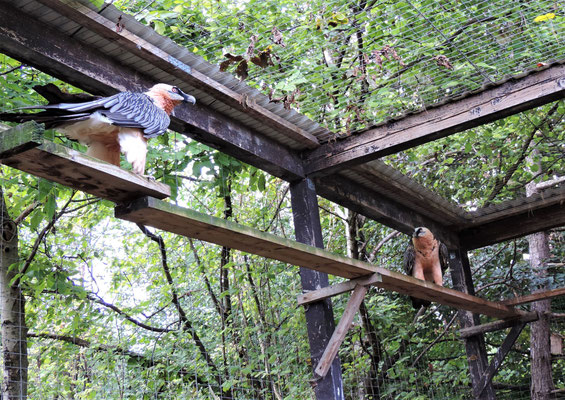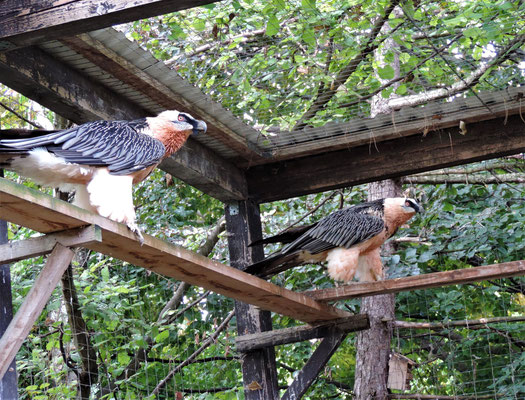
The 2019/20 Bearded Vulture breeding season has finished not a long time ago, and birds are already getting into the mood for the next one! A pair in Austria exhibited behaviour signalling the beginning of the upcoming 2020/21 breeding season for the species!
First copulation of the new season
Two residents of the Richard Faust Bearded Vulture Specialised Captive Breeding Centre in Austria that hosts the most individuals out of any other facility within the Bearded Vulture Captive Breeding Network (EEP) exhibited the first breeding behaviour for the new season! On Tuesday, 27 September, Hans Frey, the Manager of the Centre, observed the first unsuccessful copulation attempt between the pair BG 108×175. This pair has a previous background of successful breeding, having produced two hatchlings in the 2017/18 breeding season. The pair laid the first and the last egg of the season and fully incubated both clutches themselves.
The Vulture Conservation Foundation coordinates the Bearded Vulture Captive Breeding Network of zoos, specialised breeding centres and private collections, always working closely with our colleagues across Europe to ensure the best breeding results from the 180 birds within the Network. So how do we help the birds in captivity to ensure the best breeding results?
Breeding in captivity
During this time of year, the 180 captive birds that are housed in the Bearded Vulture EEP, exhibit behaviours that indicate the breeding season has begun. Staff will see breeding pairs play with nesting materials such as sticks and wool, build their nest and engage in mutual preening and exhibit aggression towards neighbouring pairs. Nest building for bearded Vultures usually begins around three months before egg laying with copulations beginning between the birds anywhere between 50 and 90 days. Once they lay the egg, the pair shares responsibilities and incubates the clutch for around 54 days, and the hatching will usually be able to fly at approximately our months of age.
Building the nest
One of the essential requirements to achieve breeding success is the quality of the nest. Each year an important number of eggs disappear or break during the incubation, and the main reason for these losses is the best quality. So to minimise losses, human keepers need to provide the necessary material at the right time.
Alex Llopis, VCF’s Bearded Vulture captive breeding manager, started providing suitable material for nest construction at Vacallent Specialised Breeding Centre early on and in small portions to give birds enough time to construct their nest and to optimise stimulation and synchronisation of the pair. Necessary materials include washed wool and appropriately sized branches. It is important to wash wool since sheep wool is covered with Lanolin (Adeps lanae). So, if it’s not washed, it fills the surface pores of the eggshell with lanolin and that prevents the CO2 – O2 gas exchange in the egg, producing the death of the embryo! These materials should also be provided at the right time. Since nest construction is closely linked to weather conditions, materials should be offered to vultures on days without rain.
Importance of captive-breeding
The Vulture Conservation Foundation (VCF) is the leading organisation working to protect Europe’s vulture species, with one of its primary goals being the restoration of the Bearded Vulture population back to its former range in Europe. To achieve this goal, the VCF has been sustainably growing its reintroduction programmes across Europe, with projects releasing captive-bred birds from the Bearded Vulture Captive Breeding Network, coordinated by the VCF on behalf of EAZA‘s EEP, across the Alps, France and Spain. Further to this, the VCF manages two specialised breeding centres in Spain that breed this species for conservation purposes – the Bearded Vulture Captive Breeding Centre of Guadalentín and the Specialised Bearded Vulture Breeding Unit at the Recovery Centre Vallcalent.
Let’s hope the 2020/21 breeding season will be a great one, allowing for several releases of birds into the wild!








